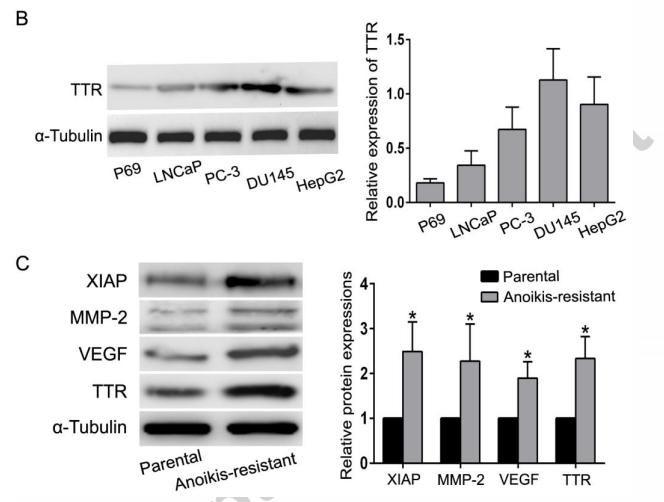Prealbumin Antibody - #DF6256
| Product: | Prealbumin Antibody |
| Catalog: | DF6256 |
| Description: | Rabbit polyclonal antibody to Prealbumin |
| Application: | WB IHC |
| Cited expt.: | WB |
| Reactivity: | Human, Mouse, Rat |
| Prediction: | Pig, Zebrafish, Bovine, Horse, Sheep, Rabbit, Dog, Chicken |
| Mol.Wt.: | 16kDa; 16kD(Calculated). |
| Uniprot: | P02766 |
| RRID: | AB_2838222 |
Related Downloads
Protocols
Product Info
*The optimal dilutions should be determined by the end user. For optimal experimental results, antibody reuse is not recommended.
*Tips:
WB: For western blot detection of denatured protein samples. IHC: For immunohistochemical detection of paraffin sections (IHC-p) or frozen sections (IHC-f) of tissue samples. IF/ICC: For immunofluorescence detection of cell samples. ELISA(peptide): For ELISA detection of antigenic peptide.
Cite Format: Affinity Biosciences Cat# DF6256, RRID:AB_2838222.
Fold/Unfold
Amyloid polyneuropathy; Amyloidosis I; ATTR; Carpal tunnel syndrome 1; CTS; CTS1; Dysprealbuminemic euthyroidal hyperthyroxinemia; Dystransthyretinemic hyperthyroxinemia; Epididymis luminal protein 111; HEL111; HsT2651; PALB; Prealbumin amyloidosis type I; Prealbumin; Prealbumin Thyroxine-binding; Senile systemic amyloidosis; TBPA; Thyroxine binding prealbumin; Transthyretin; TTHY_HUMAN; TTR; TTR protein;
Immunogens
A synthesized peptide derived from human Prealbumin, corresponding to a region within C-terminal amino acids.
Detected in serum and cerebrospinal fluid (at protein level). Highly expressed in choroid plexus epithelial cells. Detected in retina pigment epithelium and liver.
- P02766 TTHY_HUMAN:
- Protein BLAST With
- NCBI/
- ExPASy/
- Uniprot
MASHRLLLLCLAGLVFVSEAGPTGTGESKCPLMVKVLDAVRGSPAINVAVHVFRKAADDTWEPFASGKTSESGELHGLTTEEEFVEGIYKVEIDTKSYWKALGISPFHEHAEVVFTANDSGPRRYTIAALLSPYSYSTTAVVTNPKE
Predictions
Score>80(red) has high confidence and is suggested to be used for WB detection. *The prediction model is mainly based on the alignment of immunogen sequences, the results are for reference only, not as the basis of quality assurance.
High(score>80) Medium(80>score>50) Low(score<50) No confidence
Research Backgrounds
Thyroid hormone-binding protein. Probably transports thyroxine from the bloodstream to the brain.
Not glycosylated under normal conditions. Following unfolding, caused for example by variant AMYL-TTR 'Gly-38', the cryptic Asn-118 site is exposed and glycosylated by STT3B-containing OST complex, leading to its degradation by the ER-associated degradation (ERAD) pathway.
Secreted. Cytoplasm.
Detected in serum and cerebrospinal fluid (at protein level). Highly expressed in choroid plexus epithelial cells. Detected in retina pigment epithelium and liver.
Each monomer has two 4-stranded beta sheets and the shape of a prolate ellipsoid. Antiparallel beta-sheet interactions link monomers into dimers. A short loop from each monomer forms the main dimer-dimer interaction. These two pairs of loops separate the opposed, convex beta-sheets of the dimers to form an internal channel.
Belongs to the transthyretin family.
Research Fields
· Organismal Systems > Endocrine system > Thyroid hormone synthesis.
References
Application: WB Species: human Sample: HepG2
Restrictive clause
Affinity Biosciences tests all products strictly. Citations are provided as a resource for additional applications that have not been validated by Affinity Biosciences. Please choose the appropriate format for each application and consult Materials and Methods sections for additional details about the use of any product in these publications.
For Research Use Only.
Not for use in diagnostic or therapeutic procedures. Not for resale. Not for distribution without written consent. Affinity Biosciences will not be held responsible for patent infringement or other violations that may occur with the use of our products. Affinity Biosciences, Affinity Biosciences Logo and all other trademarks are the property of Affinity Biosciences LTD.
